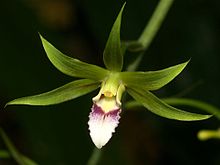Eulophia
| Eulophia | |
|---|---|
 |
|
| Eulophia euglossa | |
| Scientific classification | |
| Kingdom: | Plantae |
| (unranked): | Angiosperms |
| (unranked): | Monocots |
| Order: | Asparagales |
| Family: | Orchidaceae |
| Subfamily: | Epidendroideae |
| Tribe: | Cymbidieae |
| Subtribe: | Eulophiinae |
| Genus: |
Eulophia R. Br. |
| Species | |
|
See Species |
|
| Synonyms | |
|
|
See Species
Eulophia is a genus of approximately 165 species of orchids. It was first described by John Lindley in 1821. The name "Eulophia" was derived from the Greek words "eu" (well) and "lophos" (plume), referring to the crested ridges of the labellum (lip) in most species. This genus is abbreviated Eupha in horticultural trade.
These are usually terrestrial or ground orchids, although some are epiphytes, and rarely, lithophytes. They are distributed in shady rainforests or in open scrub or woodland in the tropics and subtropics of Africa, India,Asia, Queensland (Australia), and the Americas, although most are found in Africa. Many can survive the dry season through their large bulbous ‘corms’.
Some species, such as Eulophia petersii, have adapted to very arid environments and are among the few orchids to have truly evolved desert living species. In the frost-free, semi-arid areas of Southern California, many Eulophia species, such as E. macra, E. petersii, E. plantaginea, and E. speciosa, can be grown outdoors year-round in well-drained pots with cactus/succulent potting mix (although E. speciosa prefers being grown in pure white sand), as long as they are given ample light through the winter and a drier winter resting period. Warmer growers, such as E. pulchra and possibly even the extremely rare and difficult E. cucullata (the foxglove orchid), can probably be grown outdoors in the warmer areas of Florida and Hawaii, also.
The deciduous or evergreen leaves are usually pleated, with longitudinal veins. They are green and sheathed at the base. But in some species, the leaves may be reduced or have become brown scales. Some are leafless myco-heterotrophs.
The generally large, underground, fleshy rhizome indicates a sympodial growth habit, and this makes Eulophias fairly easy to divide and propagate, provided the grower is gentle.
...
Wikipedia
